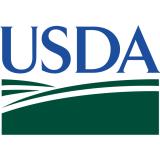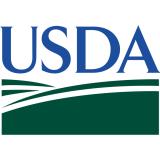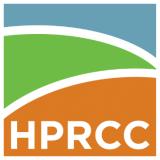Extreme Summer Heat Amplifies Impacts of the Northern Plains Drought
Key Points
- Drought conditions continue to persist across the Missouri River Basin, most severely affecting North Dakota, South Dakota, Montana, and Wyoming. Excessively early summer heat is now an added concern on top of the dry conditions that have been an issue since the fall of 2020. Record-high temperatures dominated the Northern Plains from June 3-5, with 100+°F temperatures in areas of Montana, North Dakota, and South Dakota.
- Drought impacts in the areas with extreme to exceptional drought are affecting many sectors through increased wildfire activity, decreased livestock forage and water availability, increased livestock heat-stress, reduced rural water supply and quality, reduced recreation and tourism, increased mental stress, decreased air quality, and ecological impacts due to reduced water levels. The recent extreme heat made drought impacts worse by increasing fire risk, inhibiting plant growth, and enabling harmful algae blooms.
- In the short-term, extreme summer heat is expected to return from June 18-24, with the peak of the heat occurring on June 18-22 when temperatures could reach the upper 90s°F to low 100s°F. Beyond the upcoming extreme heat, NOAA’s summer outlook (June-August) for the Northern Plains is currently leaning towards above-normal temperatures and below-normal precipitation for much of the region throughout the rest of this summer.
- The extreme summer heat will continue to worsen drought issues by further increasing fire risk, limiting water supply for livestock and societal uses, intensifying water quality issues, and continuing to cause stress on farmers, ranchers, recreationists, vulnerable or disadvantaged populations, and others affected by the drought.
Current U.S. Drought Monitor map for the Northern Plains as of June 8, 2021. The U.S. Drought Monitor is updated each Thursday to show the location and intensity of drought across the country.
U.S. Drought Monitor Categories
Current U.S. Drought Monitor map for the Northern Plains as of June 8, 2021. The U.S. Drought Monitor is updated each Thursday to show the location and intensity of drought across the country.
Current Conditions
- Drought conditions continue to persist across the Missouri River Basin/Northern Plains. Almost 99% of North Dakota is covered by drought, with 67% in extreme (D3) drought and 18% in exceptional (D4) drought. While not as extensive, South Dakota, Wyoming, and Montana are also experiencing drought that covers 80%, 72%, and 55% of the state, respectively.
- Precipitation over the last 30 days remains 5%-50% of normal across much of the Northern Plains, with the exception of a swath from western North Dakota down to western Nebraska where above-normal rains have brought some partial drought relief (Figure 1).
- Excessively early summer heat is now an added concern on top of the ongoing dry conditions that have been an issue since this fall. Record-high temperatures dominated the Northern Plains from June 3-5, with 100+°F temperatures in areas of Montana, North Dakota, and South Dakota. Maximum temperatures of at least 12°F above normal were widespread across the Dakotas, Montana, and Wyoming, with some areas reaching at least 15°F above normal (Figure 2).
- As a result of the long-term dryness and recent extreme heat, soils are very dry in many areas, which is limiting the availability of water for growing crops. Topsoil moisture is currently reported as short to very short according to the U.S. Department of Agriculture across 84% of North Dakota, 78% of South Dakota, 53% of Wyoming, and 51% of Montana.
Impacts
- Drought impacts in the areas with extreme to exceptional drought are widespread geographically and across sectors, including wildfire activity, decreased livestock forage and water availability, reduced rural water supply and quality, reduced recreation and tourism, increased mental stress, decreased air quality, and ecological impacts due to reduced water levels.
- There is much concern among producers in the Northern Plains regarding the current drought conditions. Livestock producers continue to reduce their herds due to reduced forage availability and lack of water in pastures. Some newly-planted crops have not germinated due the heat and dry conditions, and for crops that have germinated, their growth and development is behind where it should be. Some producers are expecting a reduction in yields if there is no relief from rain soon.
- Following an unusually early start to the spring fire season, wildfire activity continues to be a major issue in the Northern Plains. Over the last week, North Dakota has reported 95 fires and 3,622 acres burned. Burn bans remain in place for a majority of counties across North Dakota and two tribal reservations.
- The recent near- to record-high temperatures exacerbated drought impacts by further increasing fire risk, heat-stress in livestock, and drying of soils, which has inhibited growth and wilted or damaged plants. The hot and dry conditions have also led to the development of harmful algae blooms, which contain toxins that are harmful to livestock, wildlife, and people.
Figure 1: Precipitation 30-Day Percent of Normal: May 8-June 6, 2021
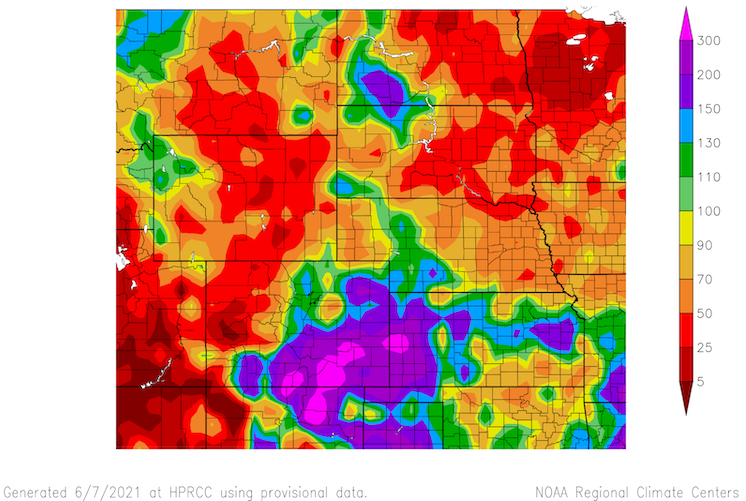
Figure 2: Departure from Normal Maximum Temperatures (°F): June 1-7, 2021
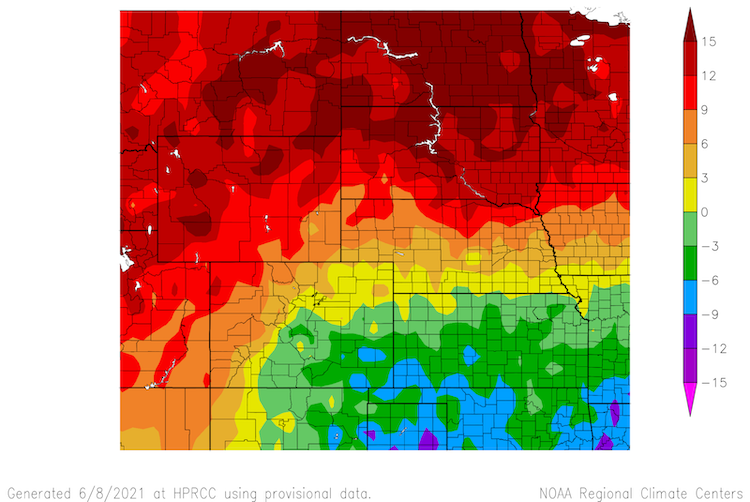
North Dakota Drought Impacts
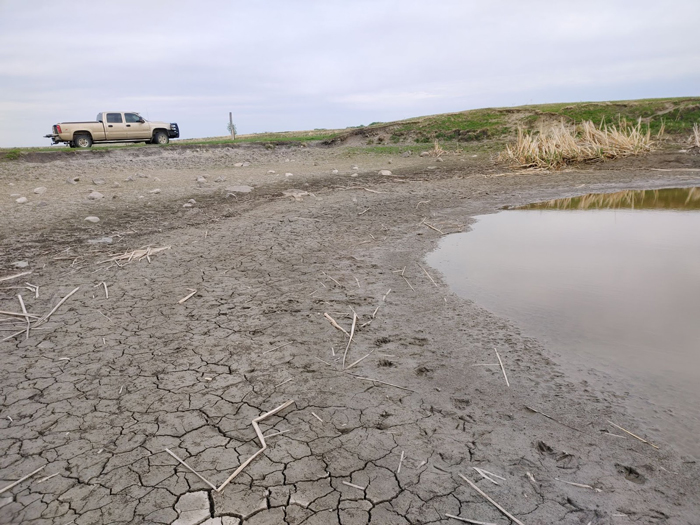
Report your drought impacts through Condition Monitoring Observer Reports (CMOR):
Outlook and Potential Impacts
- Short-term outlooks show a greater chance for above-normal temperatures and below-normal precipitation to continue over the time period of June 18-24 (Figure 3), with an increased risk for excessive heat from June 18-22 in the Northern Plains. This could mean a return of temperatures in the high 90°F to low 100°F range.
- Beyond the short-term outlooks, there is a greater chance for above-normal temperatures and below-normal precipitation to remain throughout the rest of June, and throughout July and August as well. There is more uncertainty with the precipitation outlooks, which show a chance for either near- or above-normal precipitation in some areas of the Northern Plains (Figure 4).
- The extreme summer heat expected in mid-June will continue to exacerbate drought issues by once again increasing fire risk, further limiting water supply for livestock and societal uses, intensifying water quality issues, and continuing to cause stress on farmers, ranchers, recreationists, vulnerable or disadvantaged communities, and others affected by this extreme drought.
- If the hot and dry conditions continue beyond mid-June, drought issues are likely to worsen, including additional fire risk, limited forage availability (e.g., most recent Grass-Cast maps expect North Dakota’s hardest-hit grassland areas to lose up to 50% of total production), poor crop conditions and yield reductions, increased issues with water quantity and quality, and increased stress on mental health.
Figure 3: 8-14 Day Temperature and Precipitation Outlooks
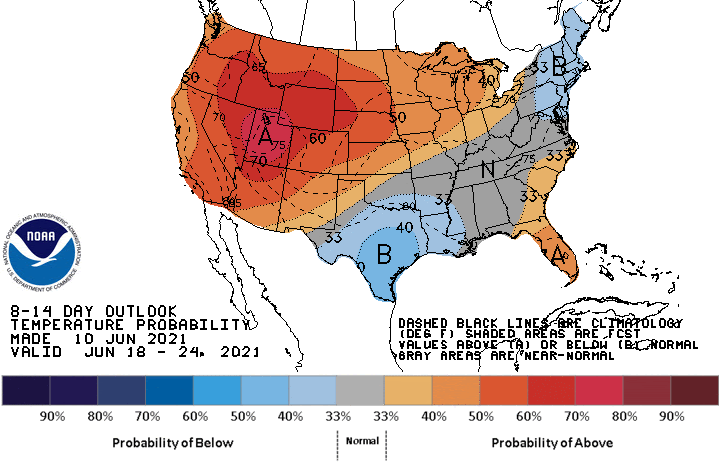
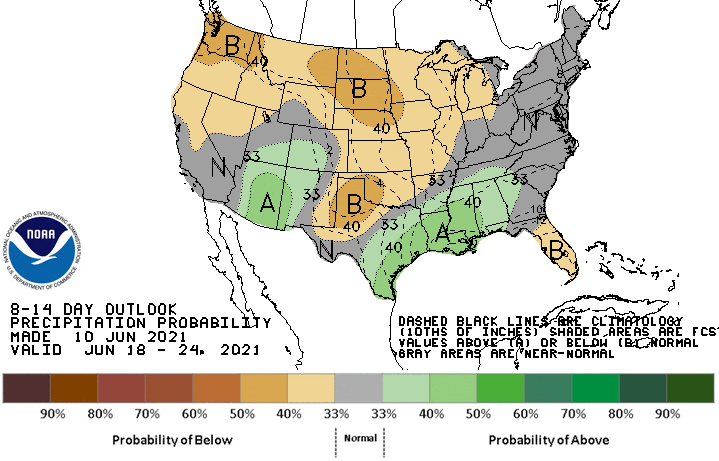
Figure 4: U.S. 3-Month Precipitation Outlook: June-August 2021
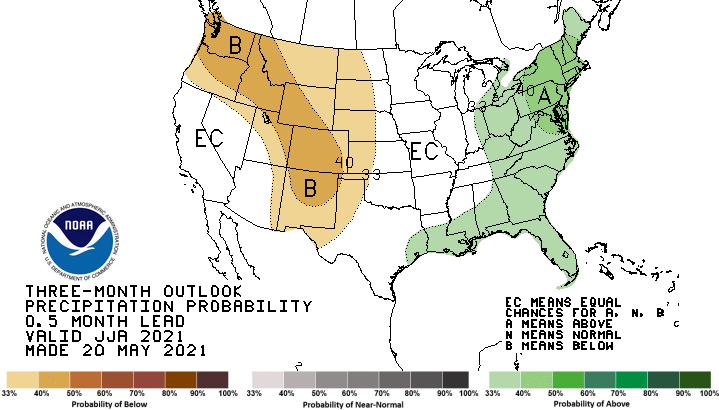
For More Information
- More local information is available from the following resources:
- The upcoming North Central U.S. Climate and Drought Summary & Outlook Webinar on June 17, 2021 will offer updated information about conditions, impacts, and outlooks.
State and Regional Resources
North Dakota
- North Dakota State University drought website
- North Dakota Response
- North Dakota State Water Commission, Drought Disaster Livestock Water Supply Project Assistance Program
- North Dakota Fire Dashboard
South Dakota
- South Dakota Drought Dashboard
- Dr. Darren Clabo’s Fire Weather Blog
- South Dakota State University Extension drought page
- SDSU Extension Drought Hour webinar recordings
- South Dakota NRCS Drought Tool and drought resources
- New South Dakota Grazing Exchange
Montana
- Montana Drought Impacts Reporter
- Montana Drought Impacts for Water Year 2021
- Montana Ag Producer Stress Resources
Wyoming
Regional Resources
- Upper Missouri River Basin Drought Indicators Dashboard
- Ranch Drought Monitoring Dashboard
- Grassland Productivity Forecast (Grass-Cast)
- USDA Disaster Assistance Discovery Tool
- Heat Safety and Tips from the National Weather Service
- National Weather Service Local Drought Information Statements
Prepared By
Molly Woloszyn & Britt Parker
NOAA/National Integrated Drought Information System (NIDIS)
Dannele Peck & Dennis Todey
USDA Northern Plains & Midwest Climate Hubs
Doug Kluck
NOAA/National Centers for Environmental Information
Ray Wolf & Central Region Headquarters
NOAA/National Weather Service
Natalie Umphlett
High Plains Regional Climate Center
This drought status update is issued in partnership between the National Oceanic and Atmospheric Administration (NOAA) and the U.S. Department of Agriculture (USDA) to communicate a potential area of concern for drought expansion and/or development within the Missouri River Basin based on recent conditions and the upcoming forecast. NIDIS and its partners will issue future drought status updates as conditions evolve.





